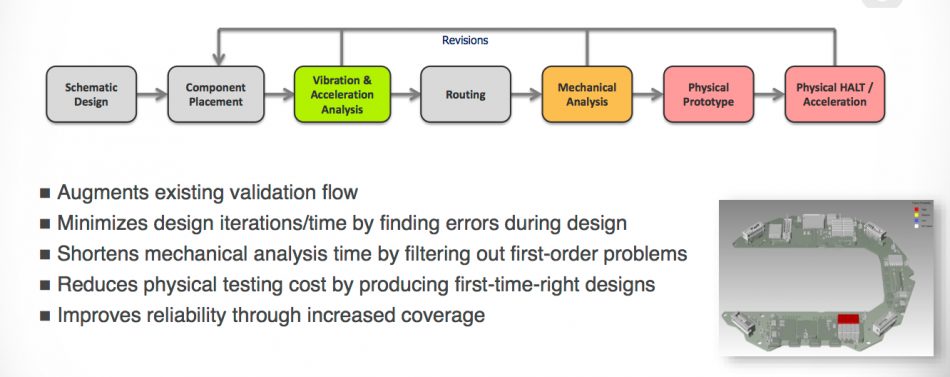Mentor’s Xpedition virtualizes simulation for ruggedized, safety-critical designs
Mentor Graphics’ latest extension to its Xpedition PCB suite provides a virtualized option for the simulation of vibration and acceleration on designs targeting rugged or safety-critical applications.
The new software aims to augment rather than replace physical simulations, particularly HALT (highly accelerated lifecycle testing). Given the conditions in which HALT-subjected designs must operate and the safety standards they must meet, Mentor believes the strongest advantage offered by software simulation is its ability to reduce time-to-market.
Existing design for reliability (DFR) techniques are dominated by a ‘shake and bake’ approach. These physically cycle a PCB through a range of vibrations, temperatures and other conditions. HALT performs these tests at a much faster rate than the design would experience in the real world. David Wiens, Business Development Manager for Mentor’s System Design Division, likens the process to putting a mobile phone in a paint mixer for two minutes.
“HALT’s been around for about 20 years, and when it first came along it was awesome. You had a process that had been taking weeks to months that then took just weeks to days. But there was still a cost,” he said. “Also, the results can vary between different machines and you can’t model the final mounting conditions.”
Even with techniques such as HALT available, designs can still experience in-the-field failure rates of 15-20% a year.
Mentor’s proposal is that virtualized test can identify various problems with a design attributable to components, mountings and other factors before physical test begins. The simulation techniques can also address mechanical stresses before they need to by physically diagnosed and analyzed by an expert engineer.
“The find-and-fix cycle for a traditional flow is very long. You identify the problem, repair it and then run the test all over again,” said Wiens. “Anything you can do to verify and address those problems earlier is going to minimize that. So, if you have fixed things before you get to HALT, that process itself will be shorter. Also, if you can address basic mechanical issues earlier, you’re allowing your experts there to concentrate on more complex problems.”
Independent research firm Tech-Clarity has looked at Mentor’s new software and echoes Wiens’ observations.
“Extending the virtual prototyping capabilities can be an important way to mitigate risk associated with product performance and reliability. Simulation capabilities such as what is available in Mentor’s Xpedition, can help companies catch problems earlier to improve quality, while saving time and cost by reducing physical tests,” says Michelle Boucher, its vice president of research.
Inside Vibration and Acceleration Analysis
Figure 1 shows how Mentor sees Xpedition’s Vibration and Acceleration Analysis feature fitting into a typical design flow, and the company summarizes the software’s main processes as follows:
- Simulate during the design process to determine PCB reliability and reduce field failure rates.
- Detect components on the threshold of failure that would be missed during physical testing.
- Analyze pin-level Von-Mises stress and deformation to determine failure probability and safety factors.
- Automated simulation setup, significantly faster than existing methods.
On the set-up side in particular, Wiens said that Xpedition as about 100X faster than other techniques during pre-processing.
Mentor has also produced a video – free-access on YouTube – that demonstrates the simulation process and there is further information at the company’s website. Availability on Xpedition Vibration and Acceleration Analysis is immediate.



